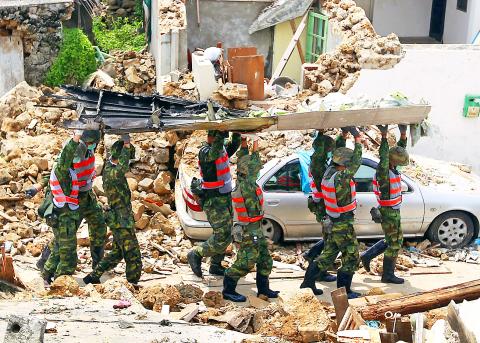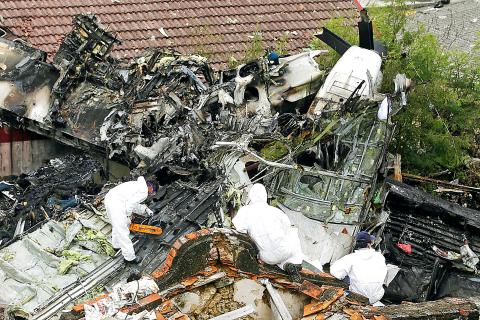The crash of TransAsia Airways (復興航空) Flight GE222 outside Magong Airport on Penghu Wednesday evening killed 48 people aboard the plane and injured 10, officials said yesterday.
Civil Aeronautics Administration (CAA) Director-General Jean Shen (沈啟) said that rescuers had located 48 bodies at the crash site in Sisi Village (西溪), but many of the bodies were not intact.
As of press time last night, CAA Deputy Director-General Lee Wan-lee (李萬里) said the rescuers have yet to confirm the identities of 17 bodies, including that of the pilot, Lee Yi-liang (李義良).

Photo: Lo Pei-der, Taipei Times
Amid questions as to why the flight was allowed to depart from Greater Kaohsiung amid inclement weather conditions, and if such a flight had violated regulations, Lee said the weather information at 7pm on Wednesday showed that the wind was blowing southwest, while the flight path was on a north-south route.
Visibility was 1.6km, with the wind blowing at a speed of 20kph and cloud ceiling of 330 feet (100.5m), Lee said.
Data also showed that winds gust were blowing at 38kph and there was a thundershower of medium intensity in the air as well, he said.

Photo: Pichi Chuang, Reuters
Based on the flight standard set for civilian aircraft, ATR72 aircraft are able to take off and land in such weather, he said.
However, an aircraft’s pilot has the right to decide if they want to land in any given situation, Lee said.
“Even if the weather was fine, the captain could still choose not to land the aircraft if he felt there was something strange with the wind and decided to go around instead,” Lee said. “CAA record shows that a Uni Air (立榮航空) flight had landed at the Magong Airport before the TransAsia crash.”

Photo: Pichi Chuang, Reuters
Lee said he would not speculate if the pilot had experienced deteriorated visibility within a very short period of time, adding that Aviation Safety Council (ASC) investigators would be able to determine the cause of the crash after decoding the information recorded in the flight data recorder and cockpit voice recorder.
CAA data showed that Flight GE222 was circling above Penghu for about 30 minutes before it prepared to land following improved visibility.
Air traffic control personnel said they received a request from the pilot to go around at 7:06pm, but they lost track of the aircraft afterward.
The visibility worsened from 1.6km to 0.8km at 7:10pm.
What happened to the pilot within the four-minute interval is considered key to the investigation.
Both of the plane’s “black boxes” were brought back to Taiwan proper yesterday afternoon.
ASC investigators said that the exterior of the cockpit voice recorder was slightly damaged, but they said that the memory of the device should still be intact. The flight data recorder looked relatively undamaged.
ASC Executive Director Thomas Wang (王興中) said the council is would issue a preliminary result of the plane crash investigation within four weeks, adding that a more detailed report could be produced within three to four months.
Casualties caused by the accident ended the best aviation safety record achievement in the past two decades.
Statistics from the CAA showed last month that the average aviation accident rate was 0.17 times per million flight hours, which was better than the global average of 0.32 times per million flight hours.
TransAsia said that each passenger’s family would receive a preliminary compensation of NT$1 million (US$ 33,360). Civil aviation regulations stipulate compensation for each deceased passenger is NT$3 million, and NT$1.5 million for passengers who suffer major injuries.
Lee said these figures do not include any settlements that might be reached in civil court cases.

The CIA has a message for Chinese government officials worried about their place in Chinese President Xi Jinping’s (習近平) government: Come work with us. The agency released two Mandarin-language videos on social media on Thursday inviting disgruntled officials to contact the CIA. The recruitment videos posted on YouTube and X racked up more than 5 million views combined in their first day. The outreach comes as CIA Director John Ratcliffe has vowed to boost the agency’s use of intelligence from human sources and its focus on China, which has recently targeted US officials with its own espionage operations. The videos are “aimed at

STEADFAST FRIEND: The bills encourage increased Taiwan-US engagement and address China’s distortion of UN Resolution 2758 to isolate Taiwan internationally The Presidential Office yesterday thanked the US House of Representatives for unanimously passing two Taiwan-related bills highlighting its solid support for Taiwan’s democracy and global participation, and for deepening bilateral relations. One of the bills, the Taiwan Assurance Implementation Act, requires the US Department of State to periodically review its guidelines for engagement with Taiwan, and report to the US Congress on the guidelines and plans to lift self-imposed limitations on US-Taiwan engagement. The other bill is the Taiwan International Solidarity Act, which clarifies that UN Resolution 2758 does not address the issue of the representation of Taiwan or its people in

US Indo-Pacific Commander Admiral Samuel Paparo on Friday expressed concern over the rate at which China is diversifying its military exercises, the Financial Times (FT) reported on Saturday. “The rates of change on the depth and breadth of their exercises is the one non-linear effect that I’ve seen in the last year that wakes me up at night or keeps me up at night,” Paparo was quoted by FT as saying while attending the annual Sedona Forum at the McCain Institute in Arizona. Paparo also expressed concern over the speed with which China was expanding its military. While the US

SHIFT: Taiwan’s better-than-expected first-quarter GDP and signs of weakness in the US have driven global capital back to emerging markets, the central bank head said The central bank yesterday blamed market speculation for the steep rise in the local currency, and urged exporters and financial institutions to stay calm and stop panic sell-offs to avoid hurting their own profitability. The nation’s top monetary policymaker said that it would step in, if necessary, to maintain order and stability in the foreign exchange market. The remarks came as the NT dollar yesterday closed up NT$0.919 to NT$30.145 against the US dollar in Taipei trading, after rising as high as NT$29.59 in intraday trading. The local currency has surged 5.85 percent against the greenback over the past two sessions, central